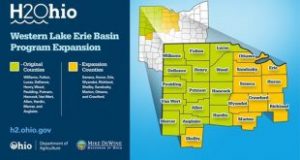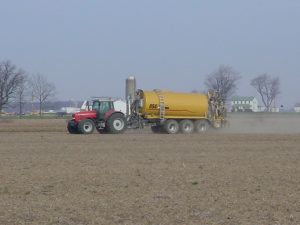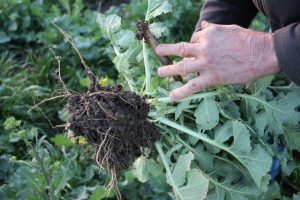Agronomy, Conservation, Homepage Slider, Water Quality
Manure Incorporation with the H2O Ohio Program
By James Hoorman, Hoorman Soil Health Services
Livestock farmers have an opportunity to be a part of the H2O Ohio program on manure incorporation. This program pays farmers for three years to apply manure to a cover crop or a growing crop in the summer or early fall. The program is designed to encourage farmers to tie up nitrogen or phosphorus in manure to decrease the risk of manure or nutrient runoff into surface water. Keeping nutrients and manure on the land and out the water helps to keep our water clean to drink (after treatment), and is good for recreational activities like swimming and fishing. 
For farmers to get state funding, the local soil and water conservation district (SWCD) needs to approve a mandatory nutrient management plan for each farm. When manure is applied, the local SWCD needs to be notified within 24 to 48 hours. Every farm needs to follow the recommended setback distances and apply manure based on Ohio NRCS 590 standards. Before manure is applied, get a copy of the weather forecast for day of application and the location for each manure application. All manure must be incorporated or injected to a minimum of 2 inches within 24 hours or applied to a growing crop.
Other requirements include manure cannot be surface applied when there is a 50% chance of precipitation exceeding 0.5 inches in a 24-hour period. To qualify, farmers must have land with a phosphorus Bray P1 soil test 50 ppm or less (100 #/P/Acre). Manure application after July 1st require a cover crop. If an over wintering cover crop is grown, the producer may be eligible for the Over Wintering Cover Crop practice. All manure needs to be applied by October 15 to qualify. The nitrogen manure application rates are based on the growing crop needs or the following year crop (example going to corn). For legumes and clovers, the rate of nitrogen in the manure is based on crop removal up to a maximum of 150# N/acre.
Farmers need to supply their local SWCD with a copy of their manure application, manure tests and analysis, and weather forecasts on an annual basis. Local SWCD’s will require the following information: 1) Date of application, 2) Place where manure is applied, 3) Number of acres, 4) Rate of application, 5) Total fertilizer or nutrient value in manure applied, 6) Manure test and analysis values, 7) Name of person applying manure, 8) Certificate holder or farmer who owns the manure, 9) Application method 10) Weather forecast for 24 hours, 11) Actual weather and soil conditions. For doing this practice, farmers can receive $35/acre for poultry manure and $60/acre for other types of manure that are applied and incorporated for up to three years. 
All manure applied after July 1st must be incorporated or injected. Grasses are great cover crop after manure application. Grasses have fibrous roots and respond to N and P applied in the manure with vigorous growth, an indication that the N & P are tied up. Over wintering cover crops like cereal rye (50#/A), barley (59#/A), triticale (60#/A), annual ryegrass (18#/A), and wheat (64#/A) can be applied if a single species is used.
Over wintering legumes and clovers include red clover (9#/A), hairy vetch (16#/A), and crimson clover (12#/A). Other legumes and clover species like Balansa clover which are not on the approved list may be able to be planted but check with your local SWCD’s before purchasing. Over winter brassica cover crops like kale, rape, or canola (4#/A) can be also be applied.
Non over wintering cover crop like oats (40#A) and winter peas (40#/A) can be grown but will not qualify for the over wintering cover crop payment. Radish is a special case. It can be grown as a non over wintering cover crop but is limited to 2#/A and can only be used in a 1/3 mixture. Other no n over wintering cover crops like Sudan, sorghum, millets (pearl, Japanese) and cowpeas needed to be planted by July 20th to qualify for the Ohio H2O program.
n over wintering cover crops like Sudan, sorghum, millets (pearl, Japanese) and cowpeas needed to be planted by July 20th to qualify for the Ohio H2O program.
Check with your local SWCD on the latest planting date which varies by species and request the All H2Ohio BMP Guidance Sheet, Exhibit B. Minimum seeding rates for single species and cover crop mixtures and planting date limitations are included in this document. For cover crop mixtures to get the extra over wintering payment, the cover crop species seed mix must include a minimum 50% of the full rate of an over wintering species.